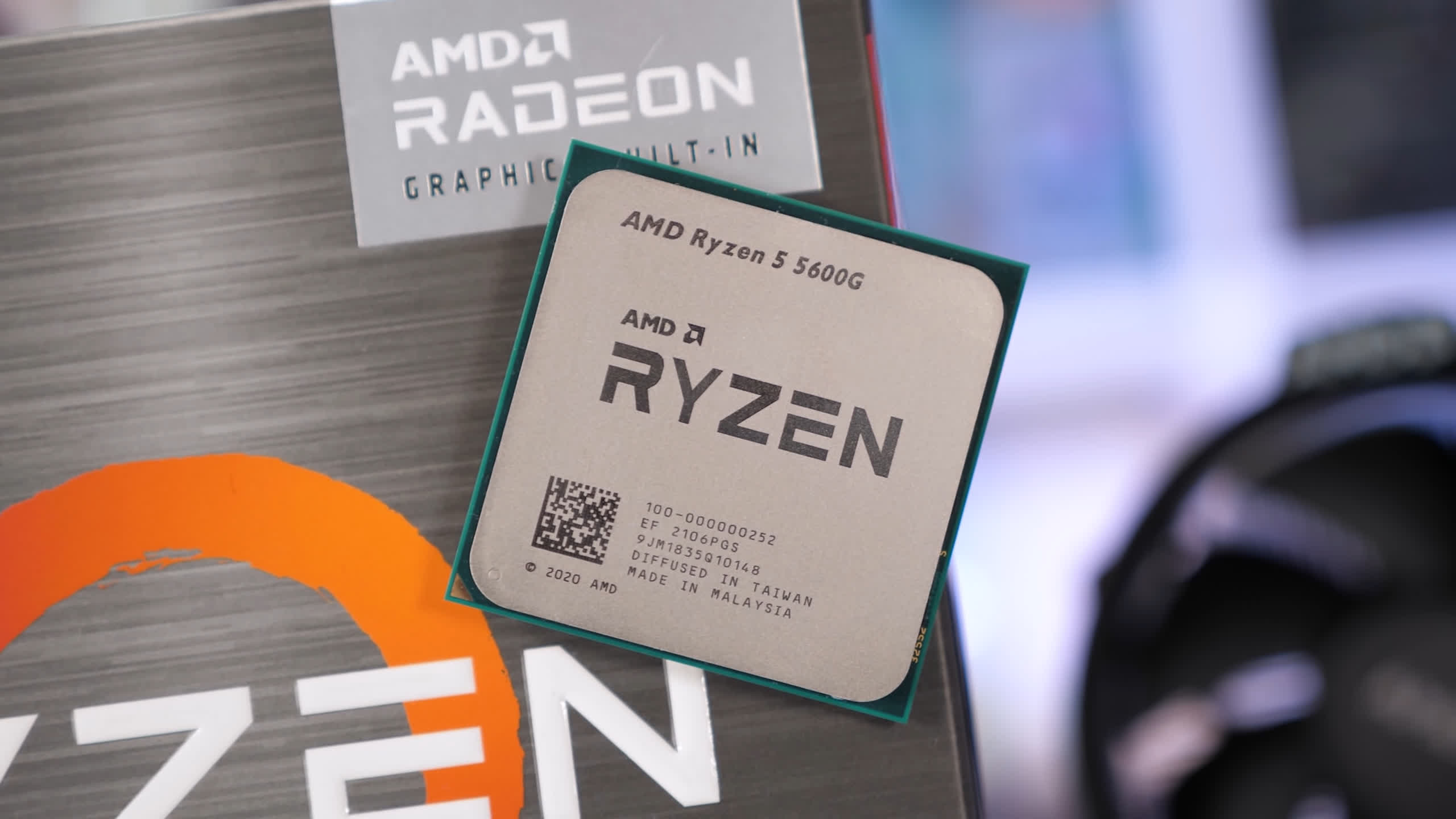The Ryzen 5 5600G is about to hit the retail market as the most affordable part sporting the Zen 3 architecture for $259. Inside the little box you also receive the Wraith Stealth cooler, which is a pretty interesting proposition. But first, some context...
Last month we checked out the Ryzen 7 5700G, which is the other APU in the 5000 series so far. If you haven't read that review, in short, we were disappointed by what's on offer as we struggled to find a practical use case for it considering the $360 asking price. For our audience, I think it's fair to say the 5700G is a niche product that only makes sense for ultra compact PCs, whether that be for home theater use, casual gaming, or some other that requires you to have a desktop PC that's the size of a gourmet burger.
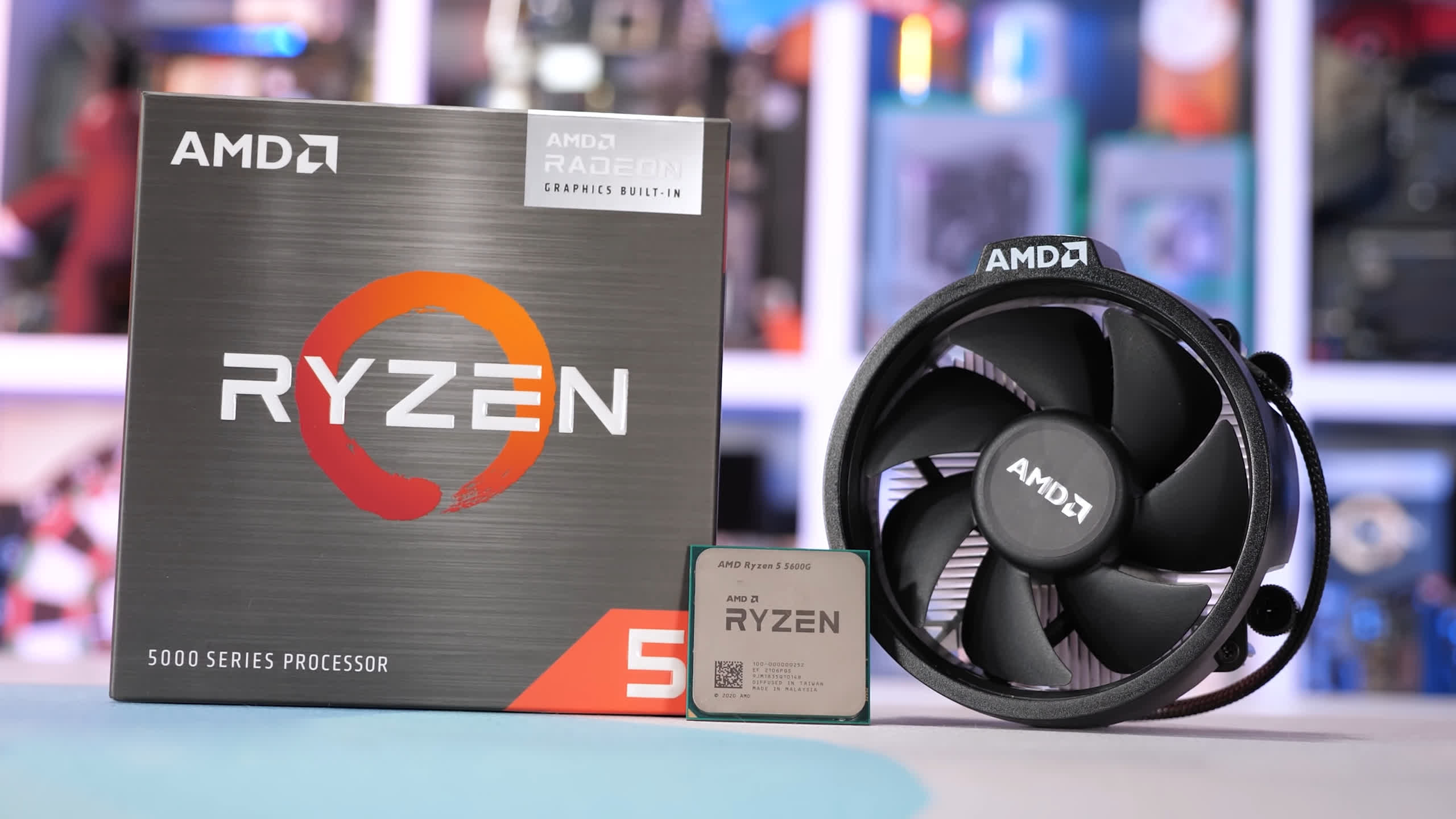
For everyone else, a mid-range 6-core/12-thread processor, such as the Intel Core i5-10400F and a second hand graphics card such as the GTX 1060 3GB will serve you far better, at least for gaming, offering roughly twice the performance for the same price.
The R7 5700G then really is a product for OEM system builders. They get to advertise their compact and affordable PCs as serious gaming systems featuring 8 cores of Ryzen 7 power, while also affording them the luxury of slapping on a Radeon graphics logo, so you know it's ready for Cyberpunk 2077 or any other modern game that it can't actually run at a satisfactory level, but of course that doesn't mater, if just has to give the impression that it's a serious gaming machine.
So for most of you, at $360 the 5700G is a bit pointless, but what about the $260 Ryzen 5 5600G, is it any better?
| Ryzen 9 5900X | Ryzen 7 5800X | Ryzen 5 5600X | Ryzen 7 5700G | Ryzen 5 5600G | |
|---|---|---|---|---|---|
| Release | November 5, 2020 | April 13, 2021 | |||
| MSRP $ | $550 | $450 | $300 | $360 | $260 |
| Cores / Threads | 12 / 24 | 8 / 16 | 6 / 12 | 8 / 16 | 6 / 12 |
| iGPU | N/A | 512:32:8 (8 CU) |
448:28:8 (7 CU) |
||
| Base Frequency |
3.7 GHz | 3.8 GHz | 3.7 GHz | 3.8 GHz | 3.9 GHz |
| Turbo Frequency |
4.8 GHz | 4.7 GHz | 4.6 GHz | 4.6 GHz | 4.4 GHz |
| L3 Cache | 32 MB per CCD (64MB Total) | 32 MB | 32 MB | 16 MB | 16 MB |
| TDP | 105 watts | 65 watts | |||
In terms of specifications, it's pretty straightforward. The 5600G is a 6-core/12-thread part, though it retains the same 16MB L3 cache, which is half that of the 5600X. Then for the iGPU, the Vega graphics are downgraded from 8 CUs to 7, and the frequency has been reduced by 5%, down to 1.9 GHz, so overall we expect a ~10% drop in iGPU performance.
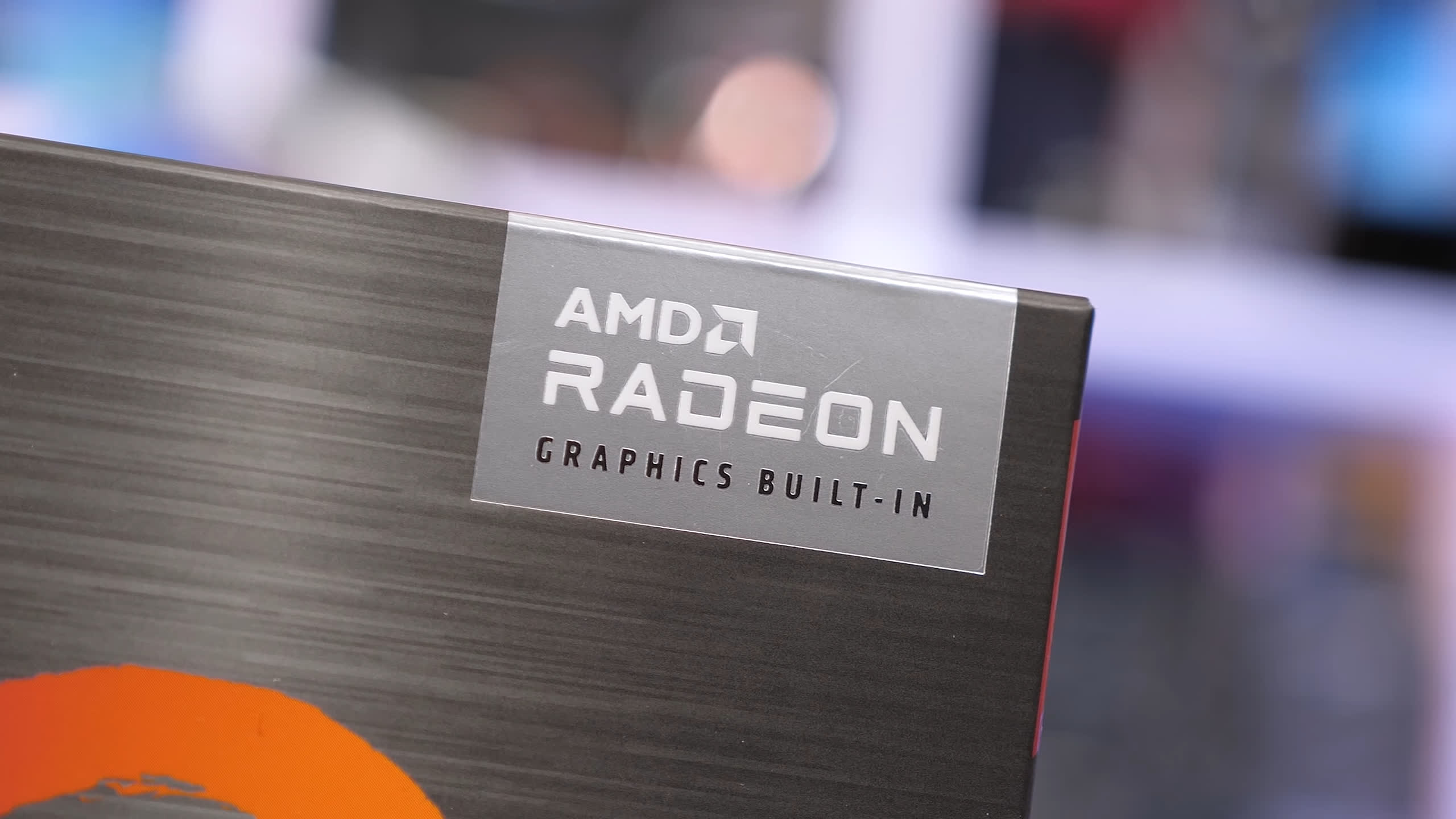
To find out if that's indeed the case we need to get into the benchmarks, and for this we've split the testing up into three sections. First we're going to look exclusively at CPU performance by testing the 5600G in applications so we can compare it with the rest of our CPU data.
Then we want to see how well it works with the Vega iGPU, and for this we'll be comparing it against the Ryzen 5 3400G, Ryzen 7 5700G and Core i7-11700, all using integrated graphics.

Finally, we've run discrete GPU tests using a GeForce RTX 3090, allowing us to compare the 5600G to a range of competing CPUs with a powerful graphics card. That should be interesting and will give us a good idea of what kind of headroom this APU offers gamers, should they upgrade down the track. So let's get into it...
Application Benchmarks
Starting as we often do with Cinebench, we see that the 5600G is comparable in this test to the Core i5-11600K and just a smidgen slower than the 5600X which is good considering the 5700G was quite a bit slower than the 5800X. I'm not entirely sure why this is, perhaps the 16MB L3 cache does a better job of servicing 6-cores opposed to 8, not sure on that one.
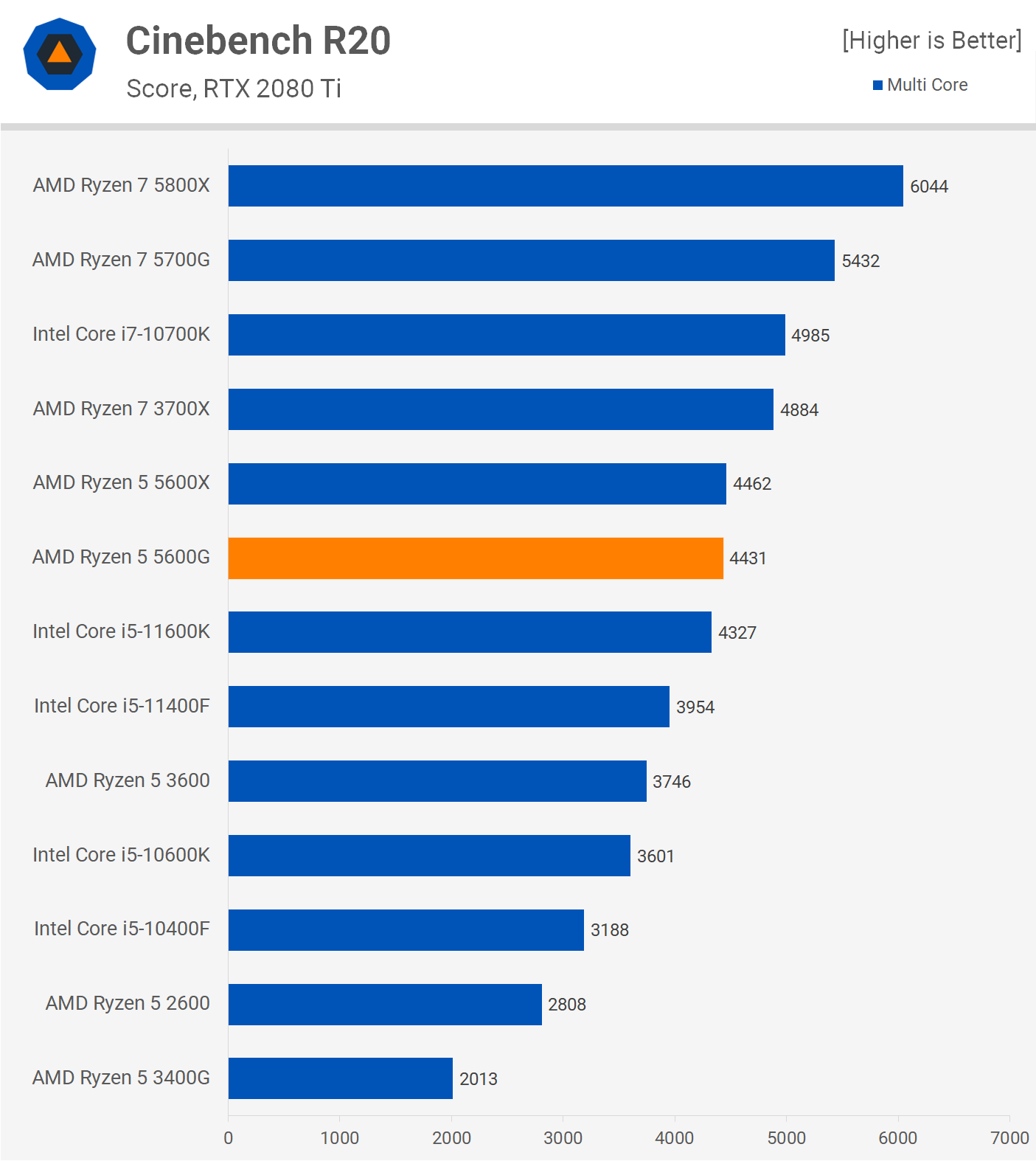
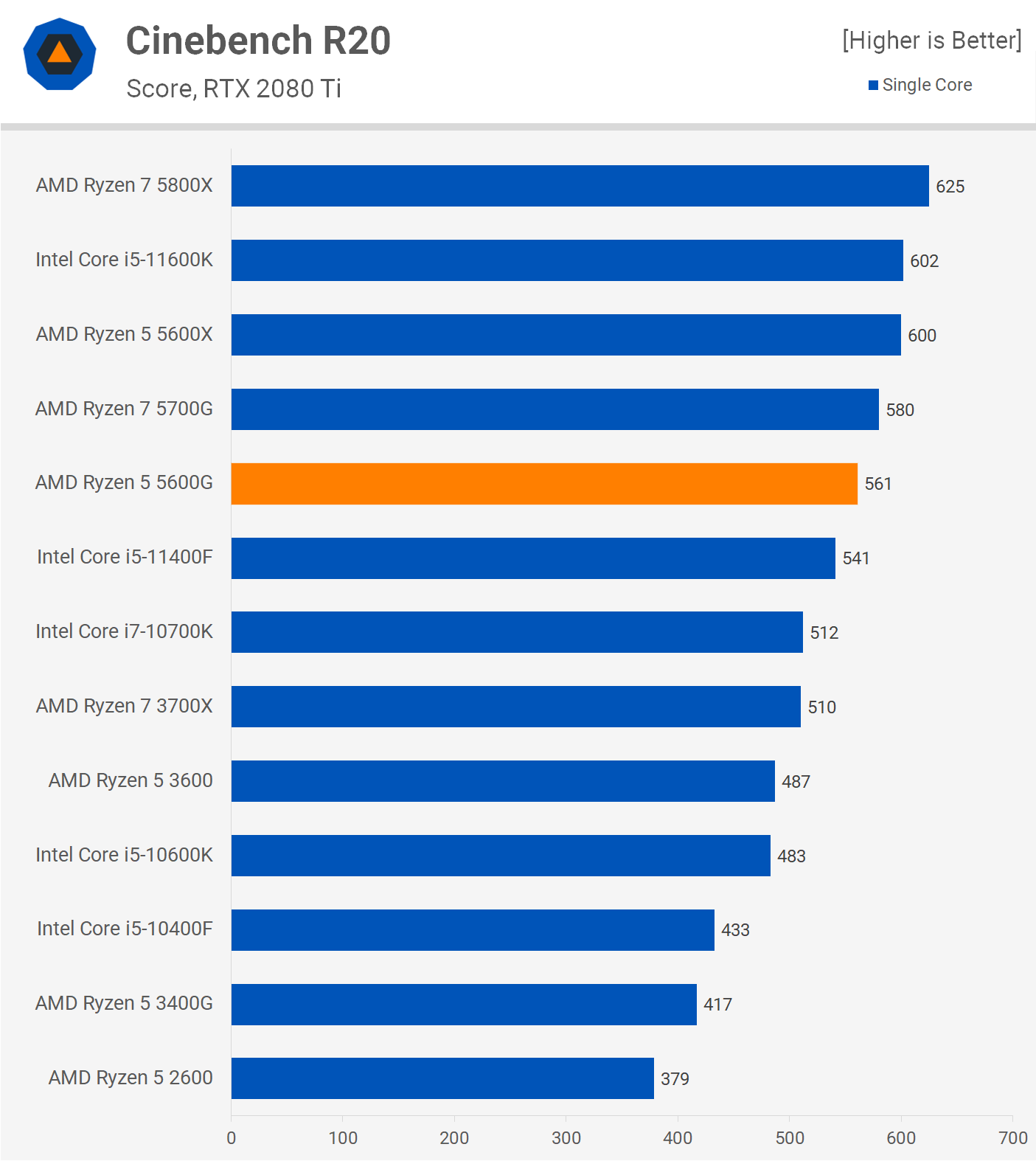
Interestingly, the single thread performance is down on the 5600X by a 7% margin which isn't massive, but it's more significant than what we saw in the multi-thread test and is comparable to the 5700G vs 5800X margin.
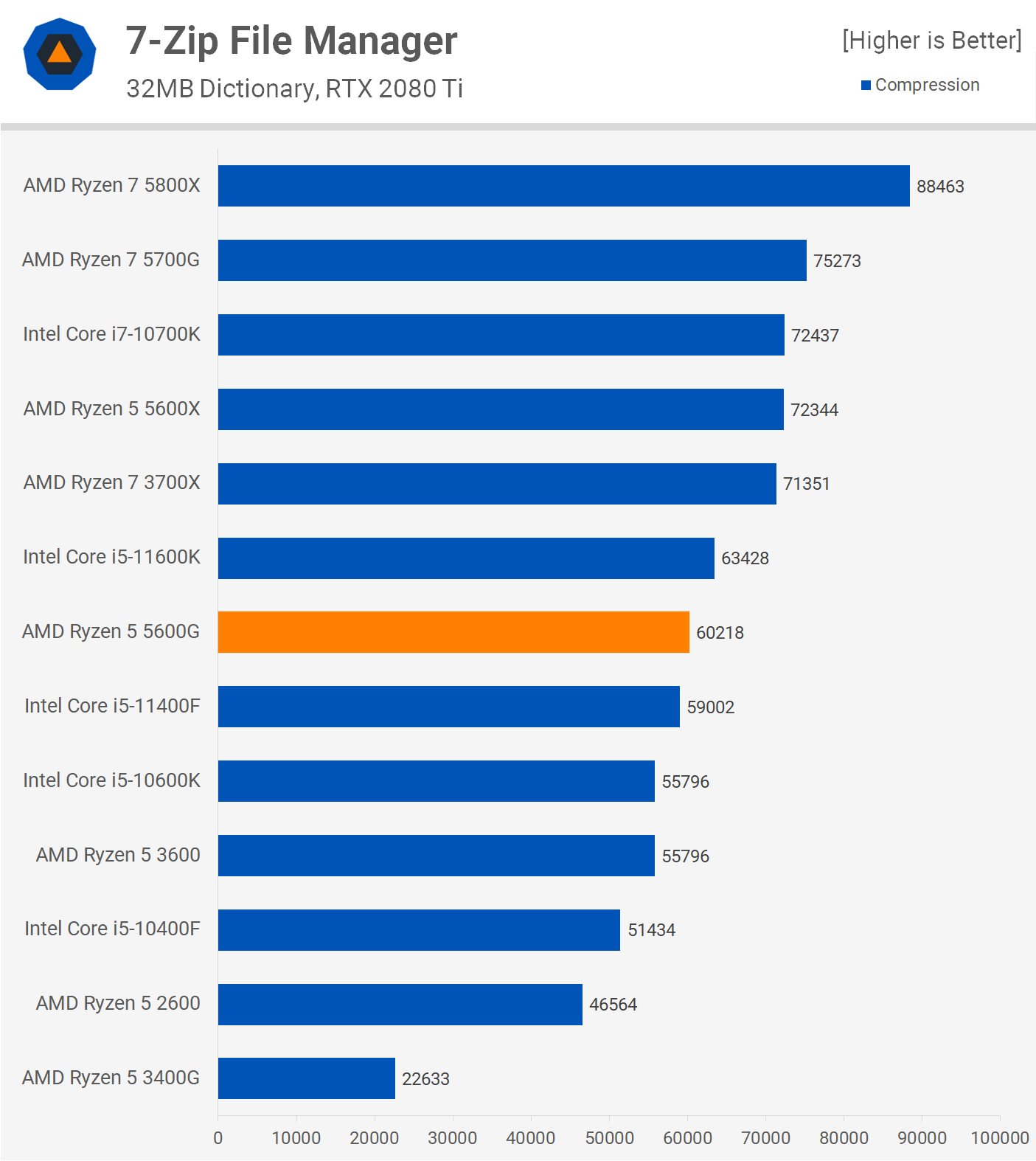
Moving on to the 7-zip file manager compression test we find that the 5600G is only comparable to the Core i5-11400F making it 17% slower than the 5600X, which is a similar margin to that seen between the 5700G and 5800X, suggesting that the L3 cache capacity plays a crucial role here.
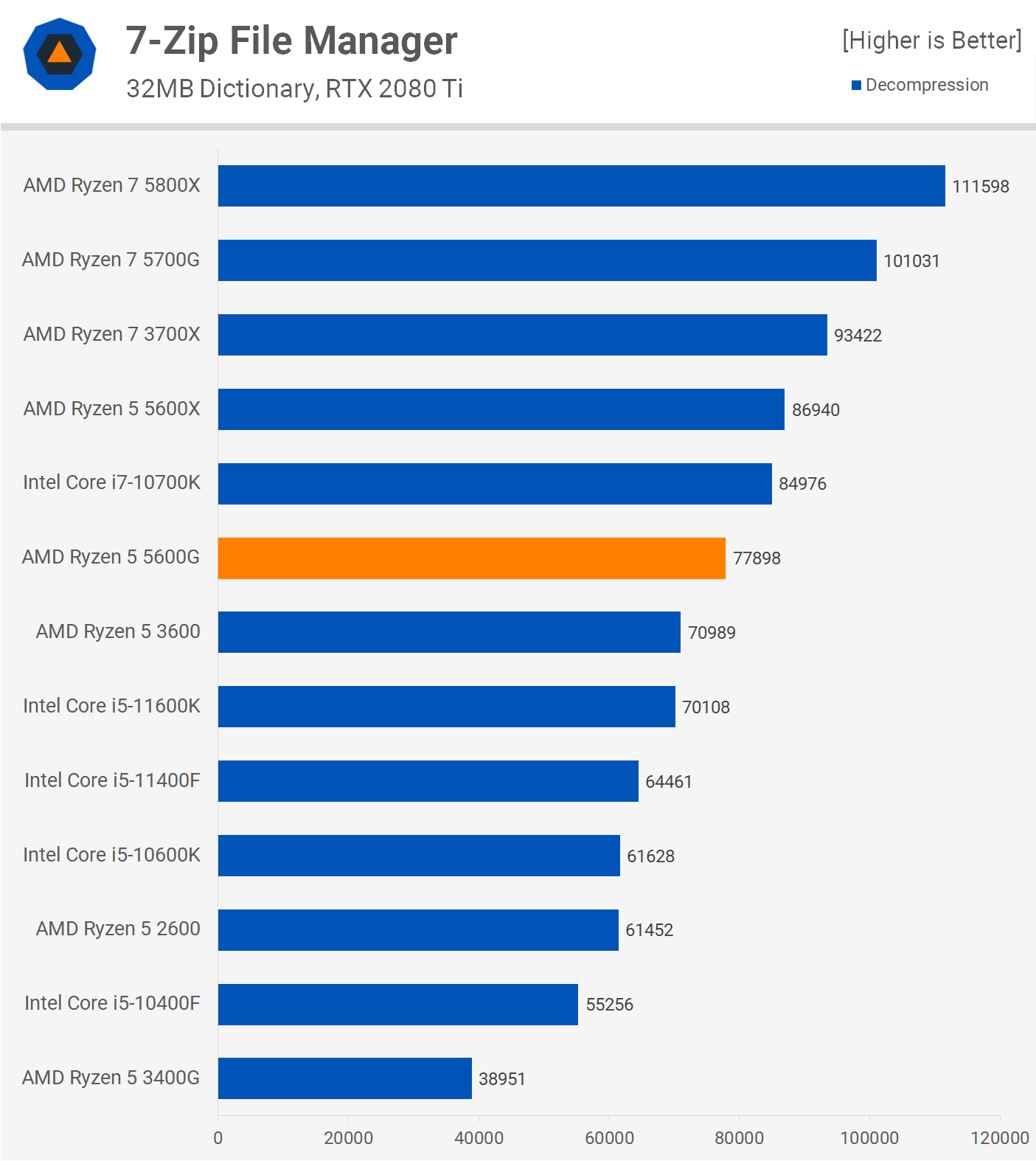
Decompression performance is more impressive when compared to the Intel competition and this is due to AMD's SMT implementation working better, and as a result the 5600G was just 8% slower than Intel's previous generation 8-core Core i7-10700. Still, when compared to the 5600X, it was 10% slower which is disappointing.
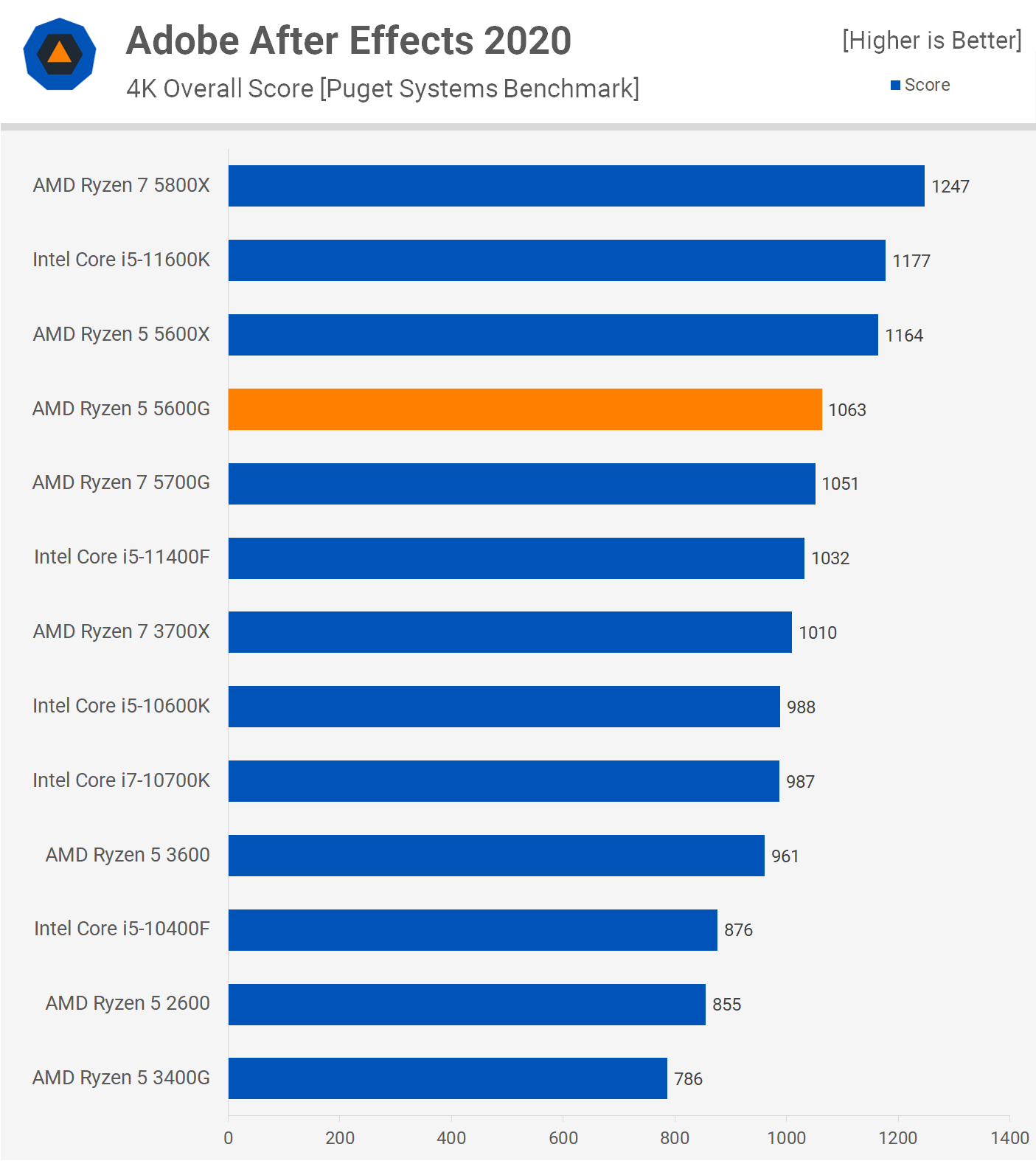
Even when testing with After Effects we find that the 5600G is ~9% slower than the 5600X and because this is a more lightly threaded application, the 5600G is comparable to the 5700G.
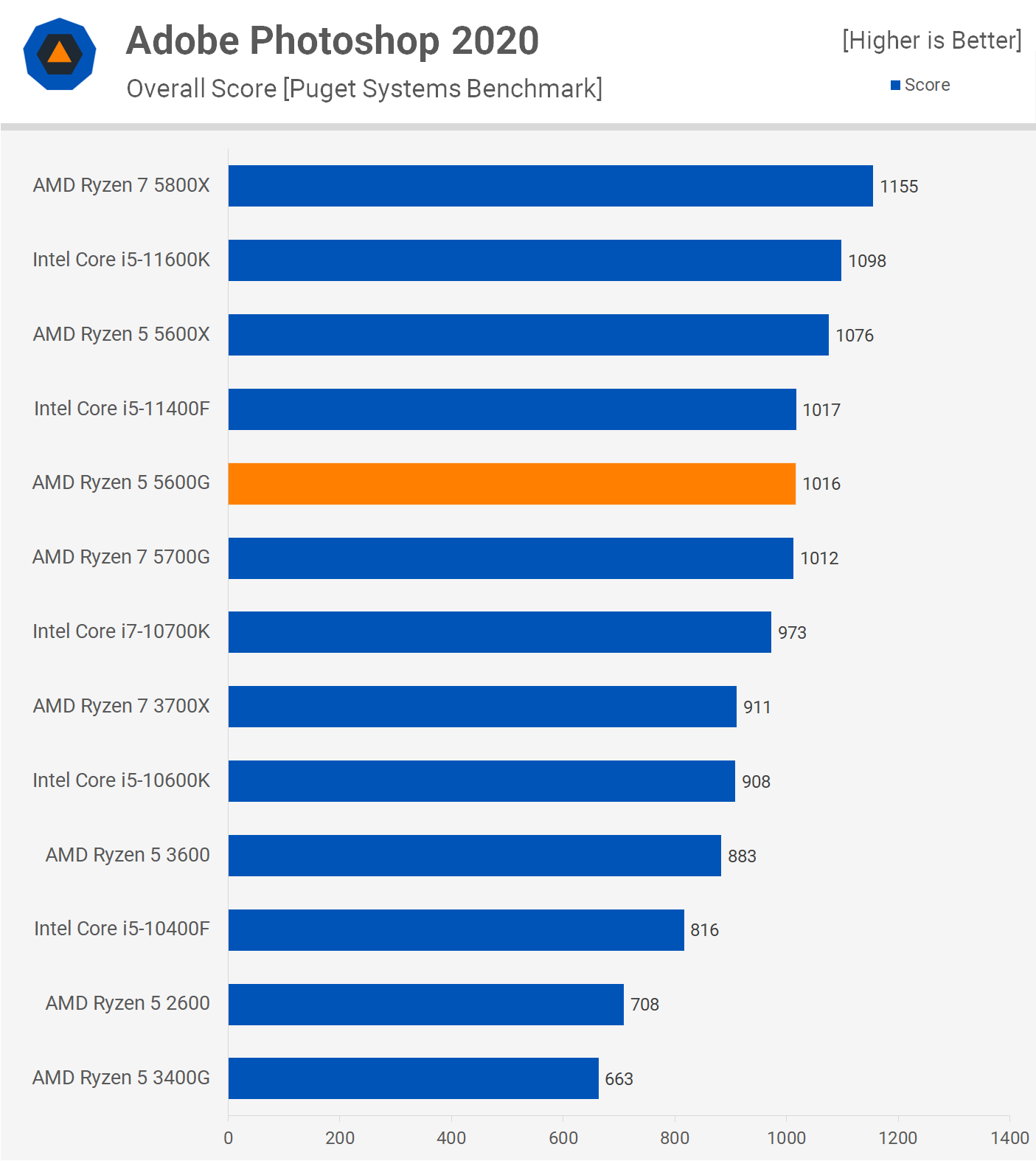
It's the same with Adobe Photoshop which is another lightly threaded application that typically only leans on 1 or 2 cores heavily. Therefore we're looking at comparable performance between not just the 5600G and 5700G, but also the new Core i5-11400F.

Adobe Premiere is a little more core-heavy and as a result the 5600G falls behind the 5700G, but when compared to the 5600X, it's only 4% slower and therefore is comparable to the Core i5-11600K in this test.

The last application benchmark we have is Blender, where the 5600G finds itself situated between the Core i5-11600K and 11400F, making it just 6% slower than the 5600X.
Power Consumption
Before we get to the gaming tests, here's a brief look at power consumption. The 5600G did consume slightly more power than the 5600X in this test despite being 6% slower. But when compared to the Intel competition, it was considerably more power efficient, especially against the 11600K.

Integrated Graphics Testing
Moving on to test the Radeon integrated graphics, we'll start with Assassin's Creed Valhalla at 1080p using the lowest possible quality settings. If you're happy with 30 fps on average with frequent dips into the mid 20s then then the 5600G will work, but for me personally I found it unplayable. I was unable to enjoy the game at those frame rates, ideally I'd want at least 40 fps on average to start enjoying this one.
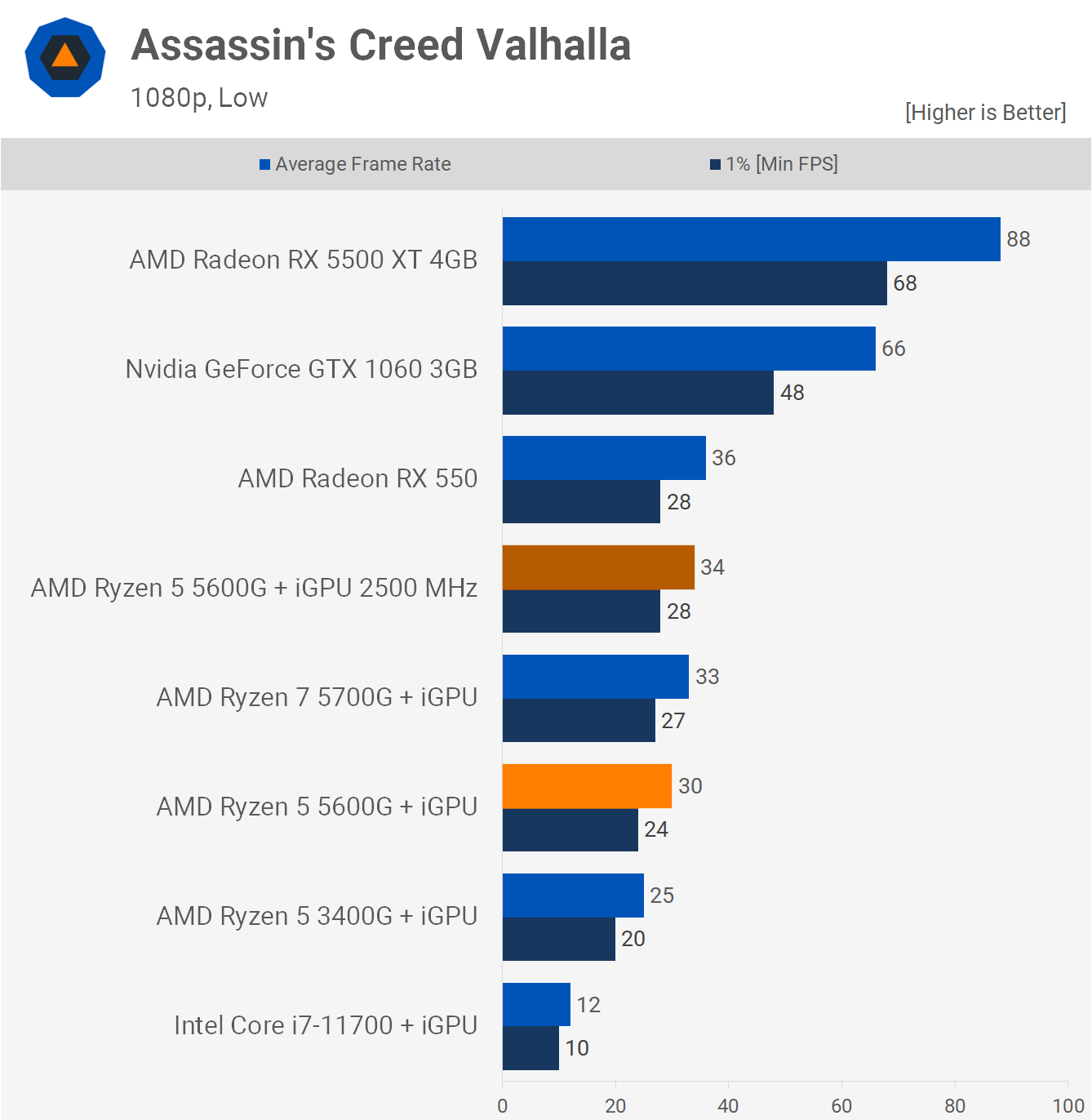
Overclocking the Vega graphics to 2.5 GHz boosted performance by 13% and that's a pretty typical GPU overclock. That said, we have increased the operating frequency by 32%, so you'd expect a more significant increase, but I'd say we're bandwidth limited here.
This took us from 30 to 34 fps on average which certainly helped, but wasn't enough to start enjoying this title. As far as iGPU performance goes, it was very good, destroying Intel's best socketed desktop options available right now.
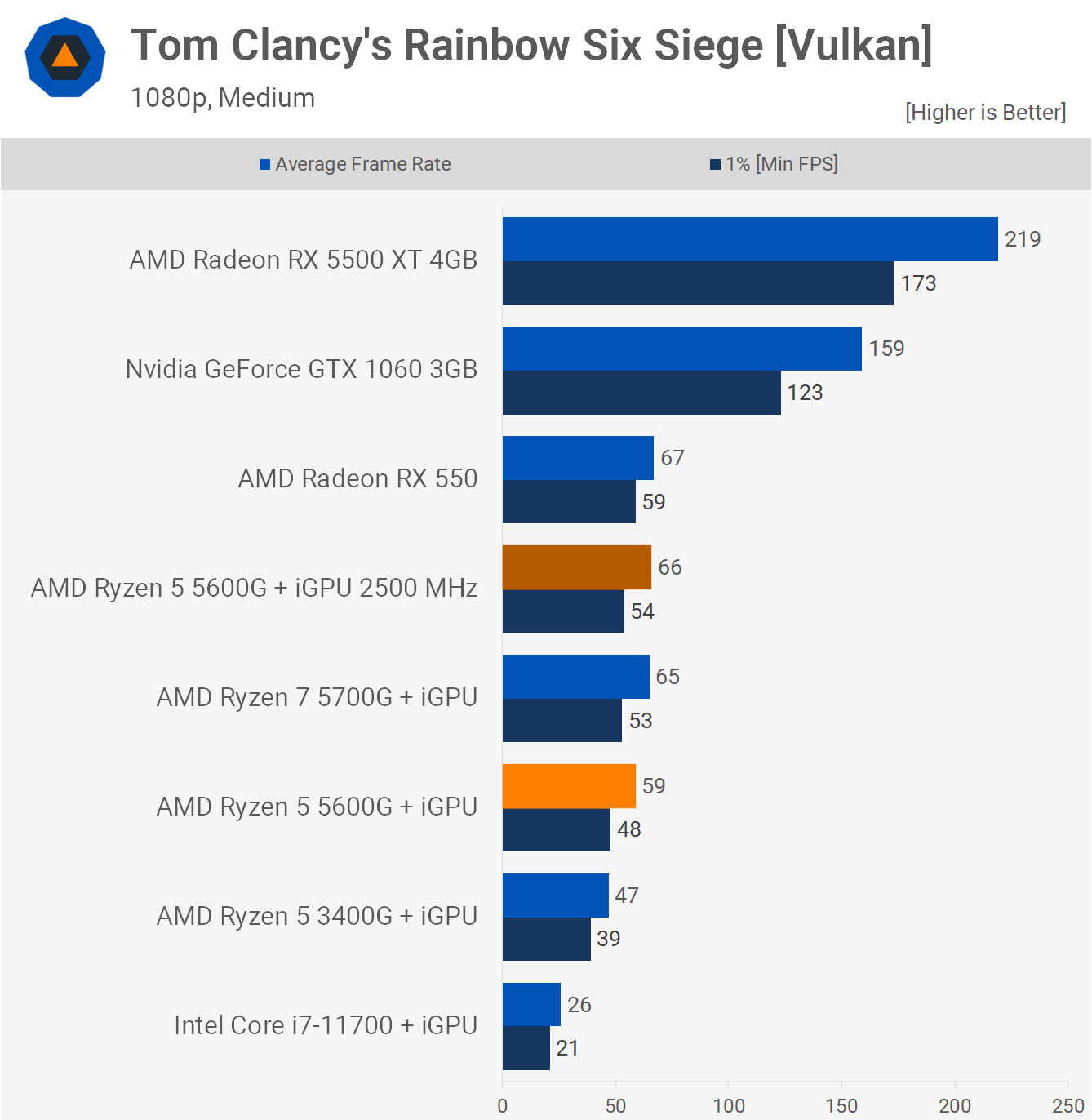
Where the 5600G is very usable, in my opinion, is with Rainbow Six Siege. Here the game was very enjoyable with almost 60 fps on average, so perhaps not at the level of competitive gameplay, but it was playable in the more casual sense. Overclocked we received a 12% boost taking the average to 66 fps and now the 5600G is able to match a stock 5700G as well as the discrete Radeon RX 550.
When compared to the 3400G, the 5600G was 26% faster out of the box and a massive 127% faster than the Intel Core i7-11700. So for an iGPU solution it's very impressive, but when compared to three generation old budget graphics cards like the GTX 1060 3GB, it looks a bit pathetic offering half the performance.
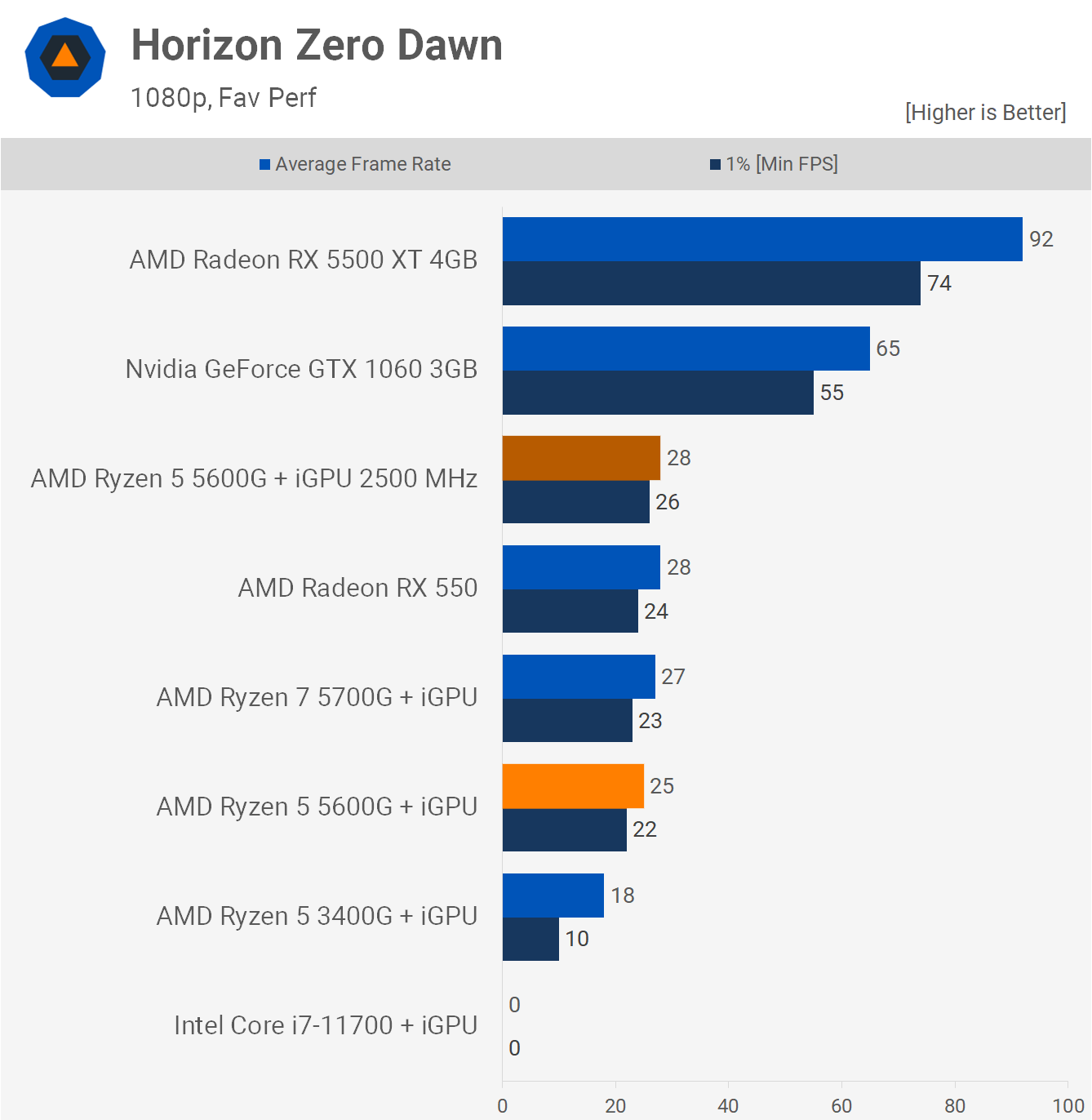
Unfortunately games like Horizon Zero Dawn aren't playable using integrated graphics. Here the 5600G was good for just 25 fps on average, and overclocking only boosted that to 28 fps, or the same performance you'll receive from the RX 550.
You're looking at twice the performance with an old GTX 1060 3GB, or slightly more in this example. At least the AMD iGPUs ran this game, the Core i7-11700 kept crashing out when I tried to load into a level.

Despite being a late 2018 release, Shadow of the Tomb Raider is another AAA title that simply can't run on integrated graphics. The 5600G was good for just 29 fps on average and wasn't much better than the 3400G, we did see an improvement in 1% low performance but that's likely a result of the extra CPU cores. Even with the 5600G overclocked the GTX 1060 3GB was still able to provide 163% greater performance.

Doom Eternal runs well using the lowest settings at 1080p, and this saw the 5600G render 46 fps on average and 52 fps once overclocked. That means stock the 5600G was 21% faster than the 3400G and RX 550.

Watch Dogs: Legion is another modern game that you won't be running on integrated graphics, at least at 1080p. With the lowest quality settings enabled, the 5600G rendered just 26 fps on average and then 30 fps once overclocked with regular dips into the mid 20s. So once again we're looking at just shy of half the performance you'd get from the GTX 1060 3GB.

Counter-Strike: Global Offensive is a good example of a game that plays really well on low-end graphics solutions, including iGPUs. Here the 5600G was good for 101 fps on average at 1080p using the medium quality settings and we were able to boost that a further 24% via overclocking, hitting 125 fps on average and at that point you're receiving a high refresh rate experience.
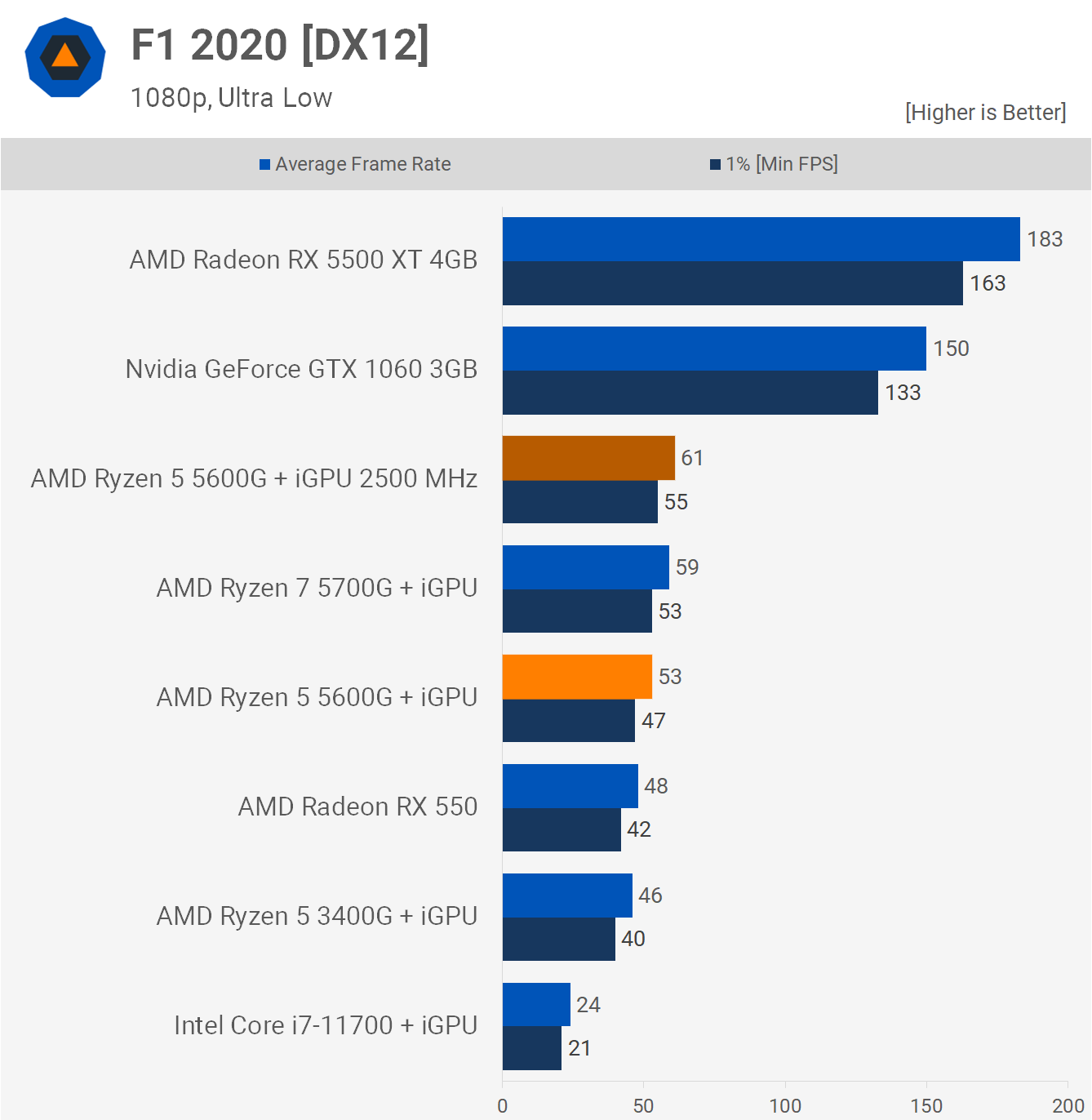
F1 2020 also plays reasonably well with the 5600G, spitting out 53 fps on average when stock and that made it slightly faster than the RX 550. Our overclock boosted performance by 15%, allowing for 61 fps on average, and at this point the gaming experience is excellent for an iGPU.
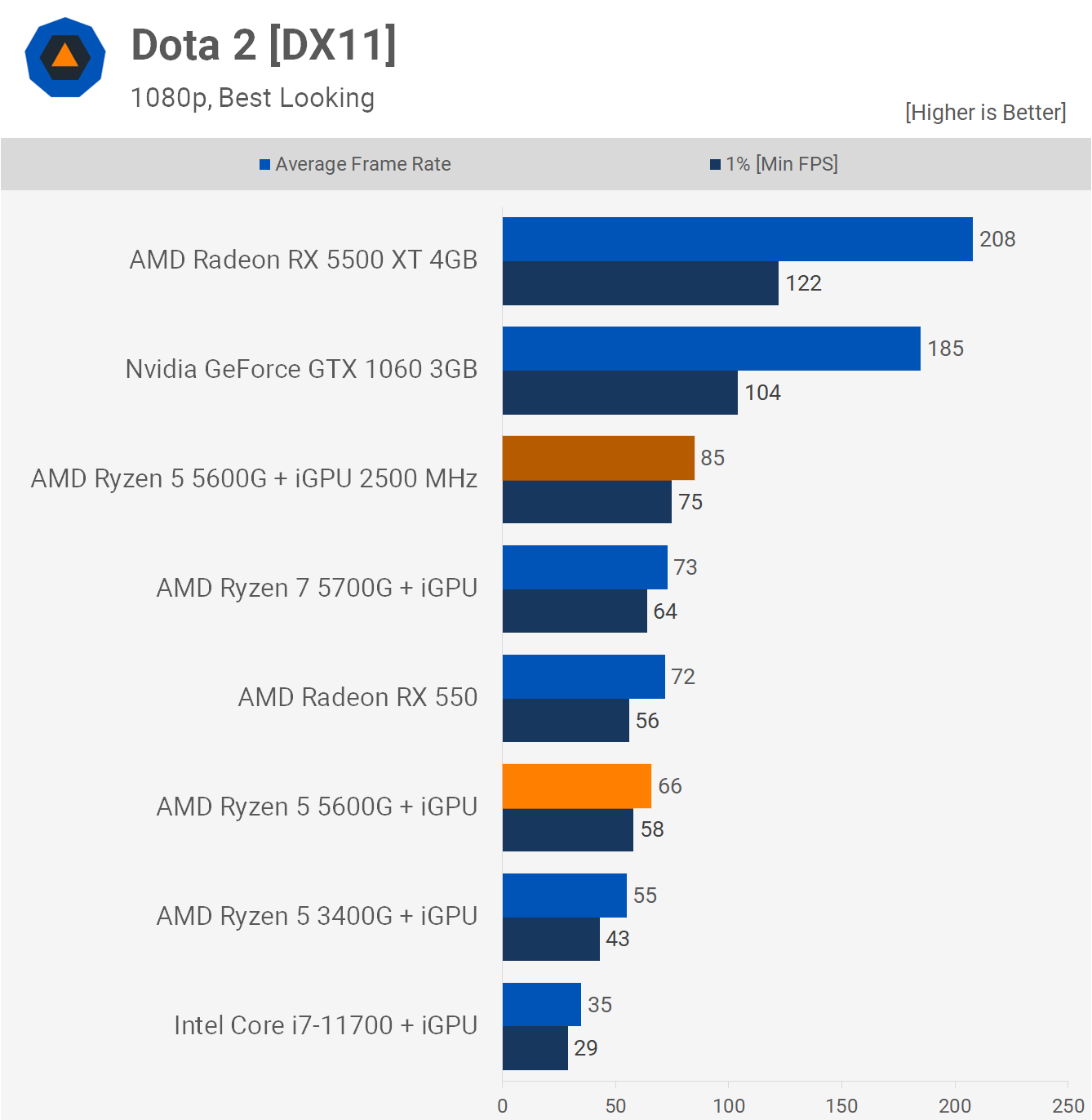
Our last integrated graphics test is Dota 2, a game that's known to run on basically anything and proving that point is the 5600G with 66 fps on average at 1080p using the highest possible in-game quality settings. The overclock allowed for a big 29% increase in performance hitting 85 fps on average, so very smooth playable performance.
Gaming Benchmarks (dGPU)
Time to check out discrete GPU performance with the GeForce RTX 3090, and we'll start with F1 2020. Here the 5600G allowed for 240 fps on average which is about the same level of performance you receive with the Core i5-10400F. That means this APU is 11% slower than the 5600X, and 6% slower than the 5700G, which is not a bad result.
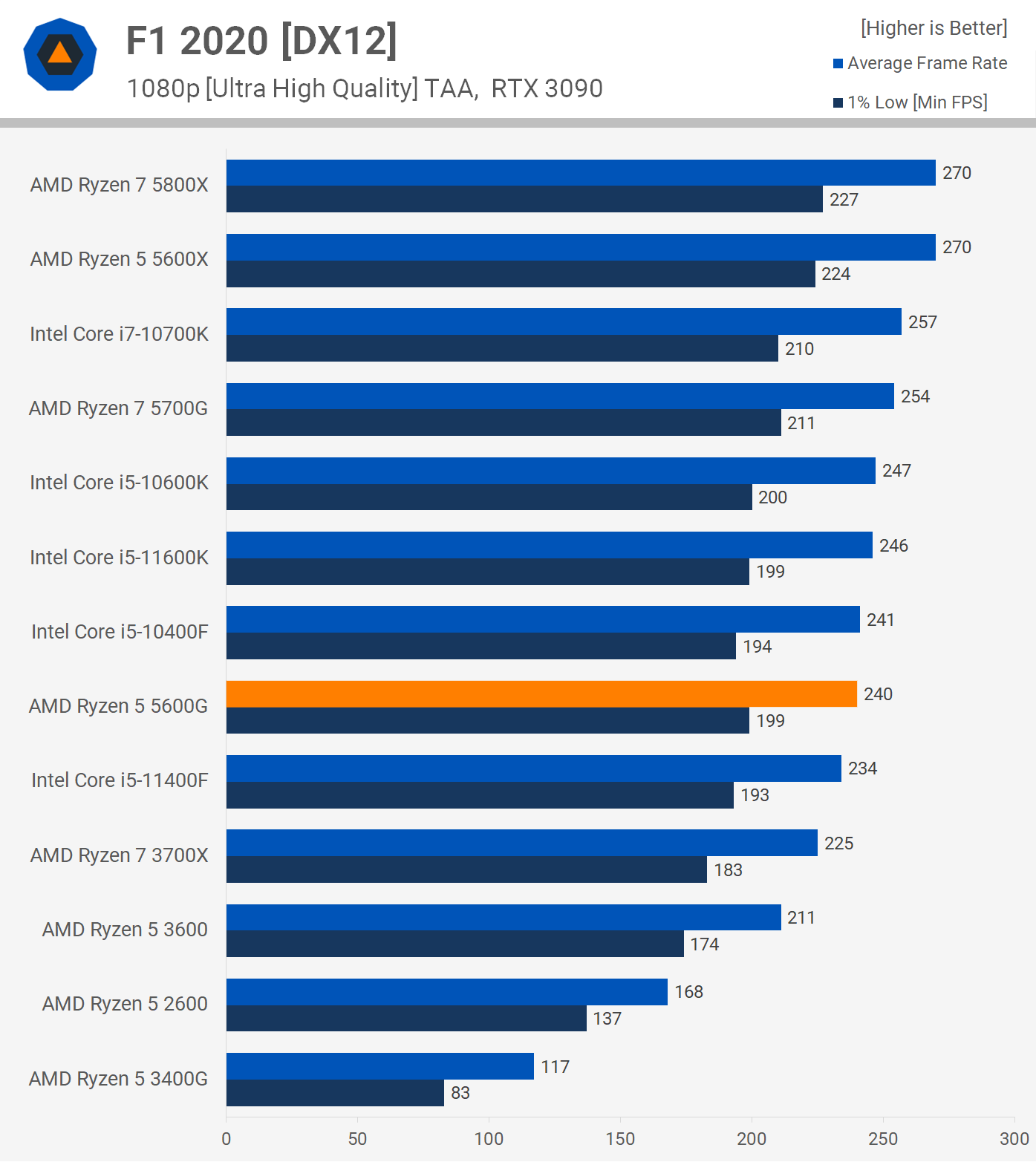
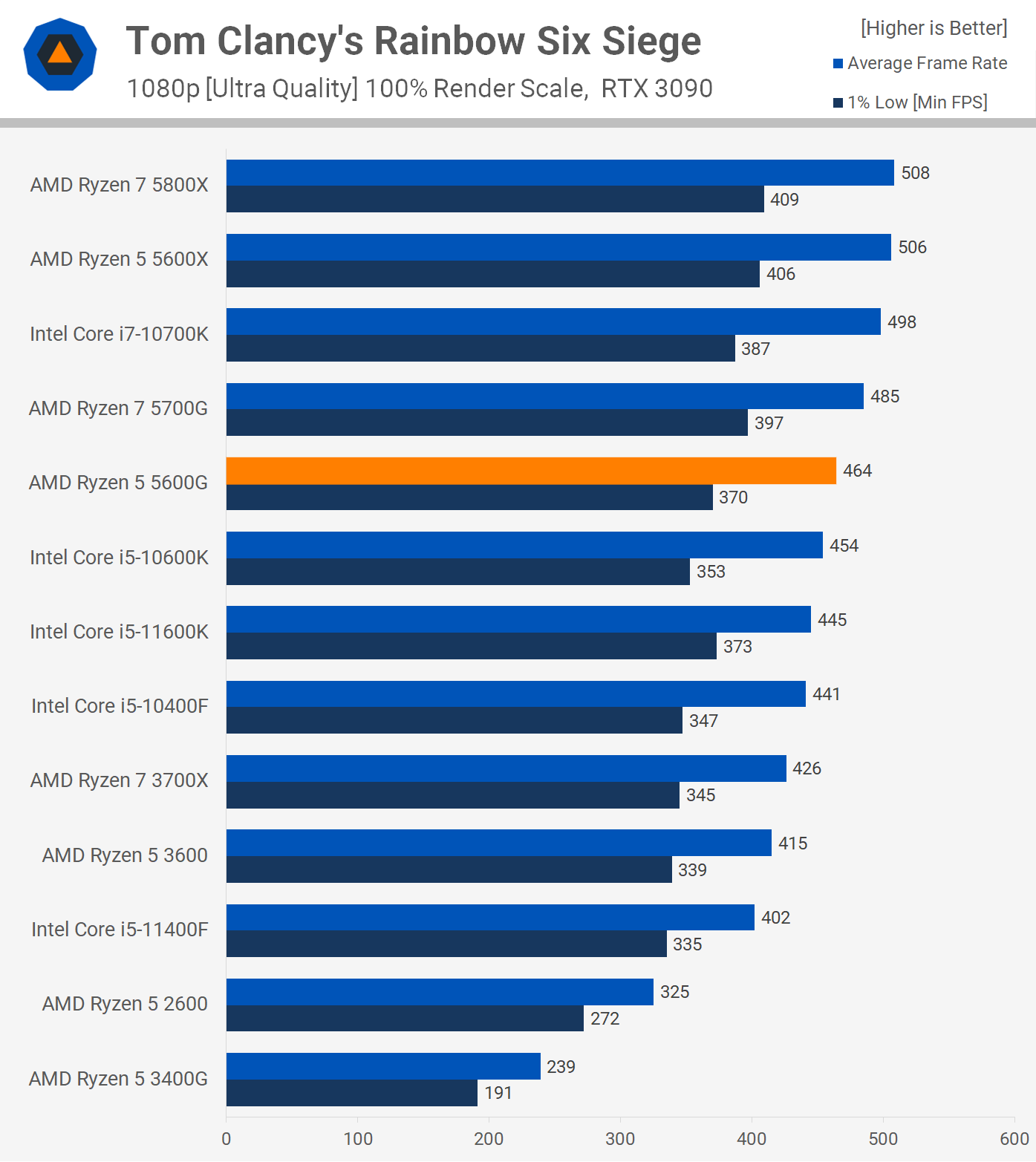
The 5600G fairs better in Rainbow Six Siege, not only did it allow for 464 fps on average but it was also just 9% slower than the 5600X, allowing it to beat all 10th and 11th-gen Core i5 processors.
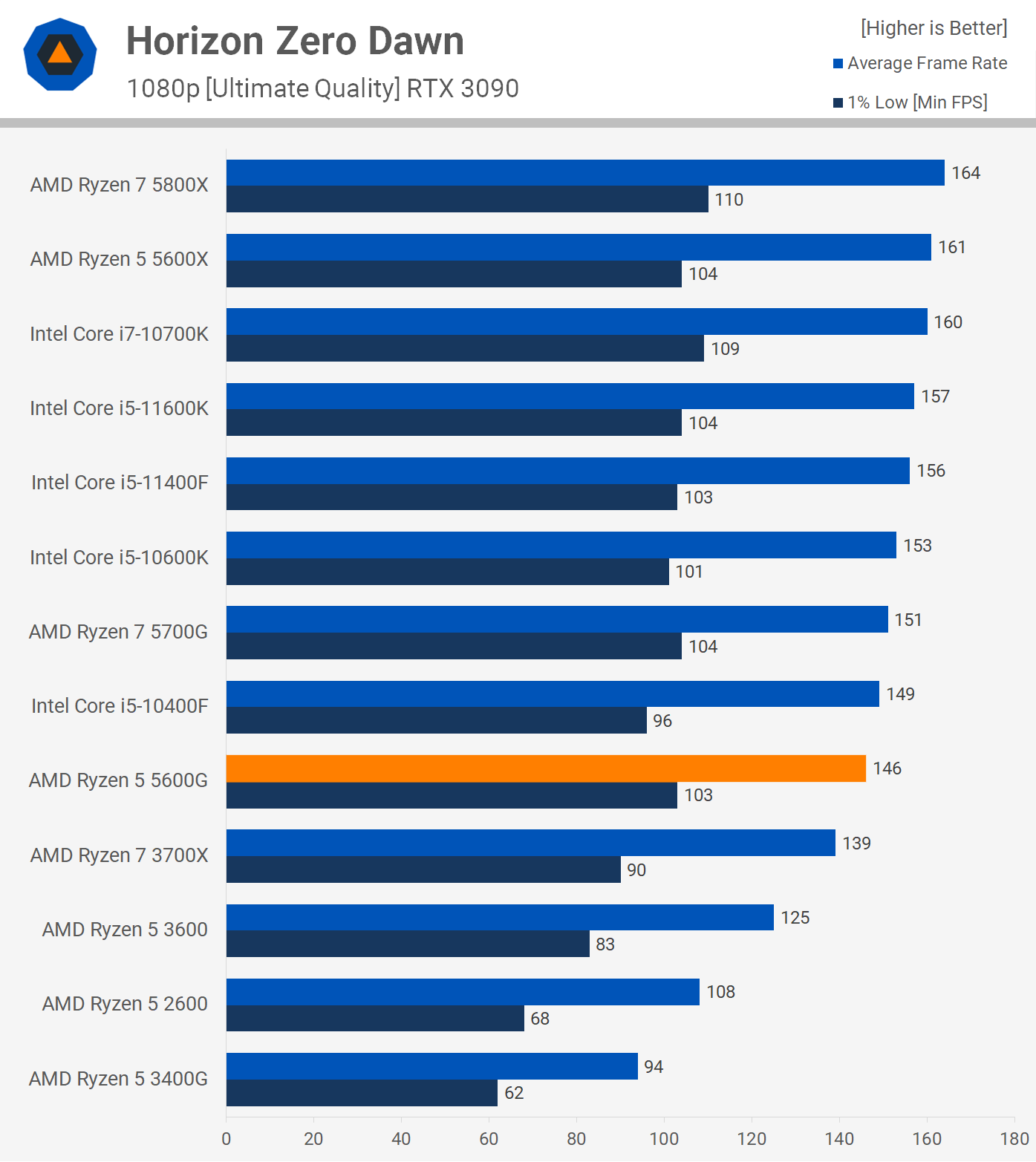
Moving on to Horizon Zero Dawn, we find that the 5600G is comparable to the Core i5-10400F and not a great deal faster than the older Ryzen 7 3700X. When compared to the 5700G, it was just 3% slower and 9% slower than the 5600X.
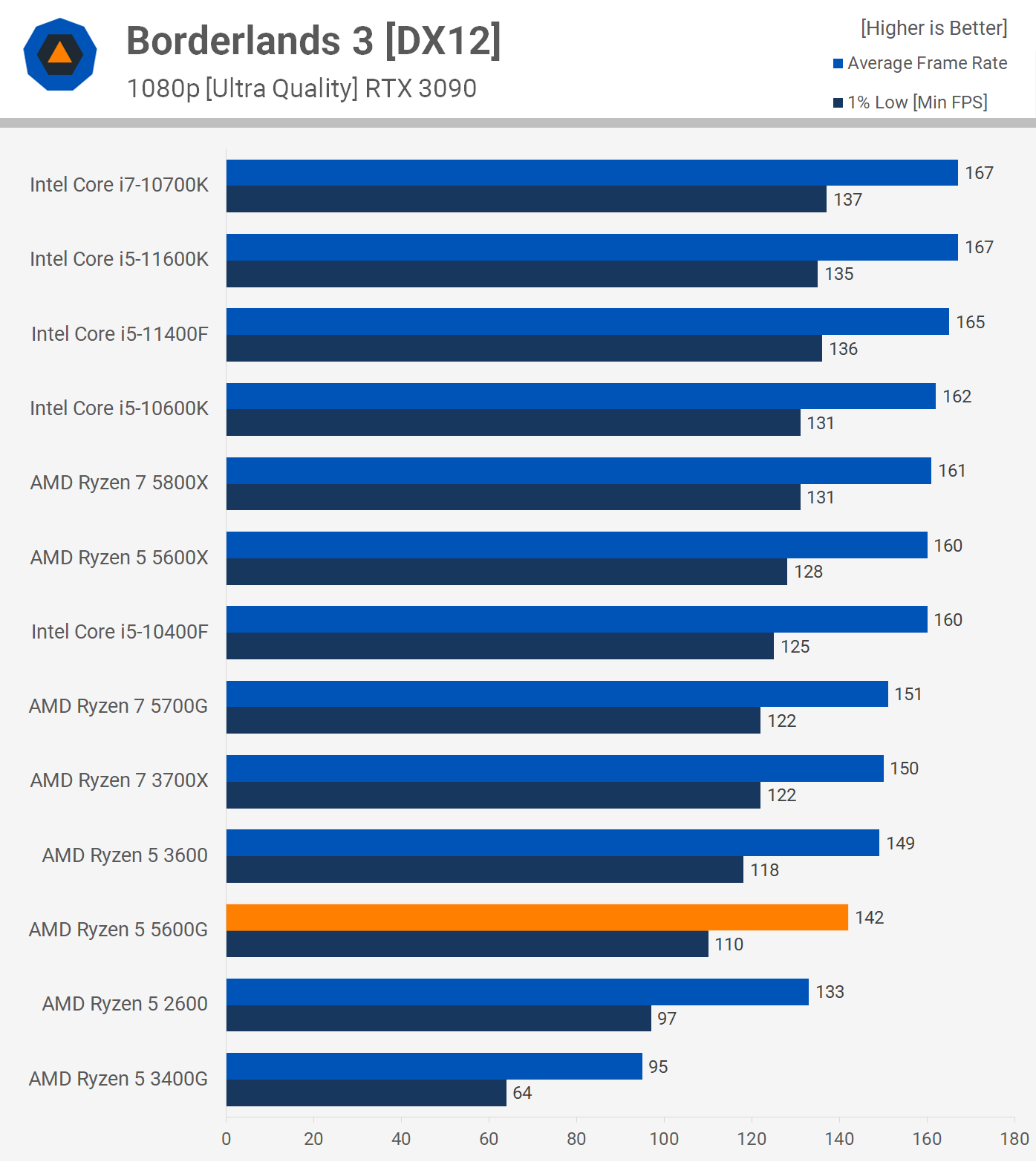
In Borderlands 3 the 5600G doesn't look particularly impressive, allowing for 142 fps on average making it 11% slower than the 5600X and the Core i5-10400F. Of course, that's still highly playable performance, but the fact that it was slower than the Ryzen 5 3600 is a little concerning.

The 5600G only matched the Ryzen 7 3700X when testing with Watch Dogs Legion, though that did mean it also matched the 5700G. It was 12% slower than the 5600X and just 8% faster than the older Ryzen 5 3600.
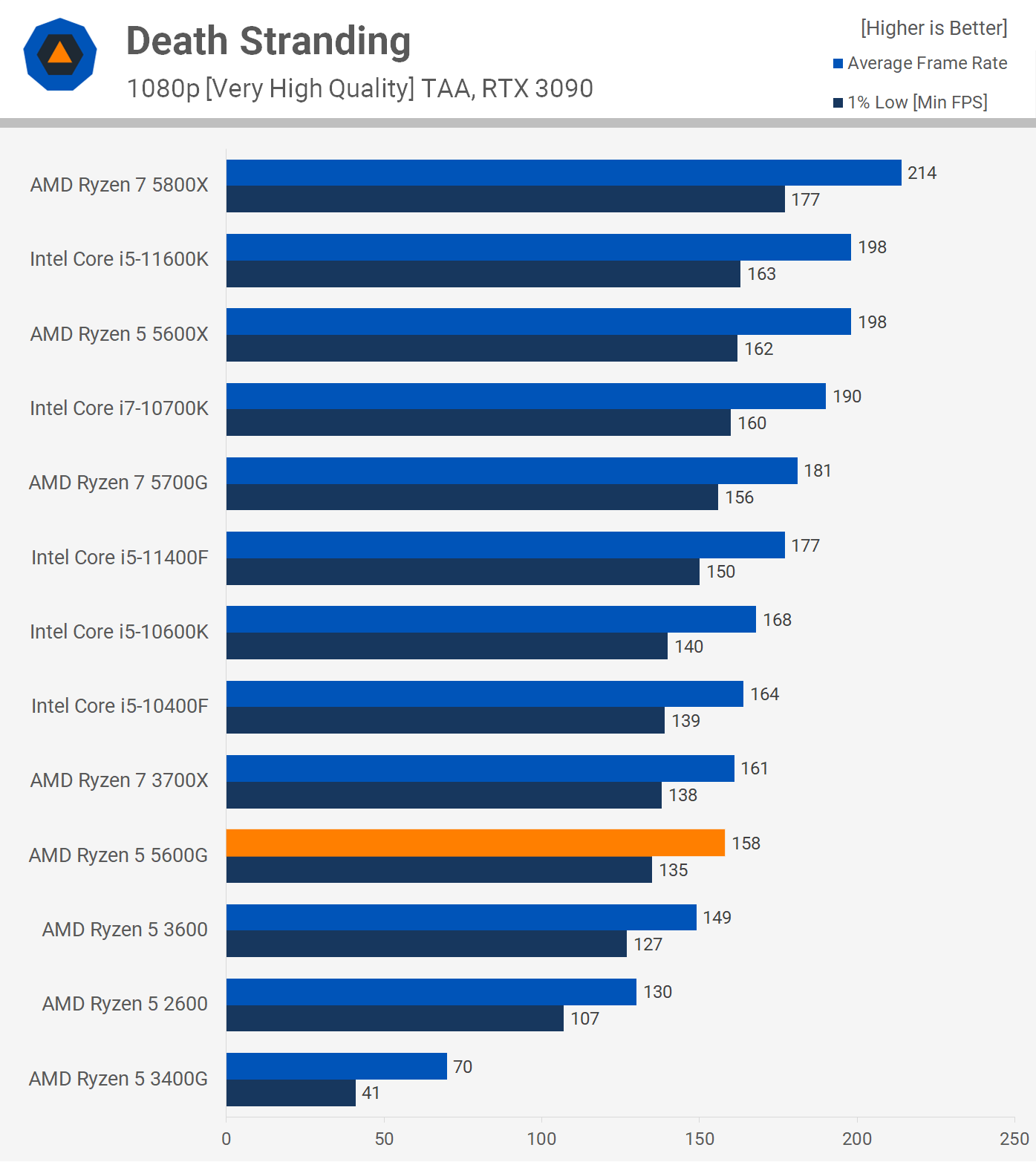
The 5600G also looks fairly weak relative to many of the other CPUs tested in Death Stranding, averaging 158 fps and placing somewhere between the 3700X and 3600, though it was closer to matching the performance of the 8-core model. It was quite shocking to see the 5600G trailing the 5600X by a massive 20% margin in this game though.
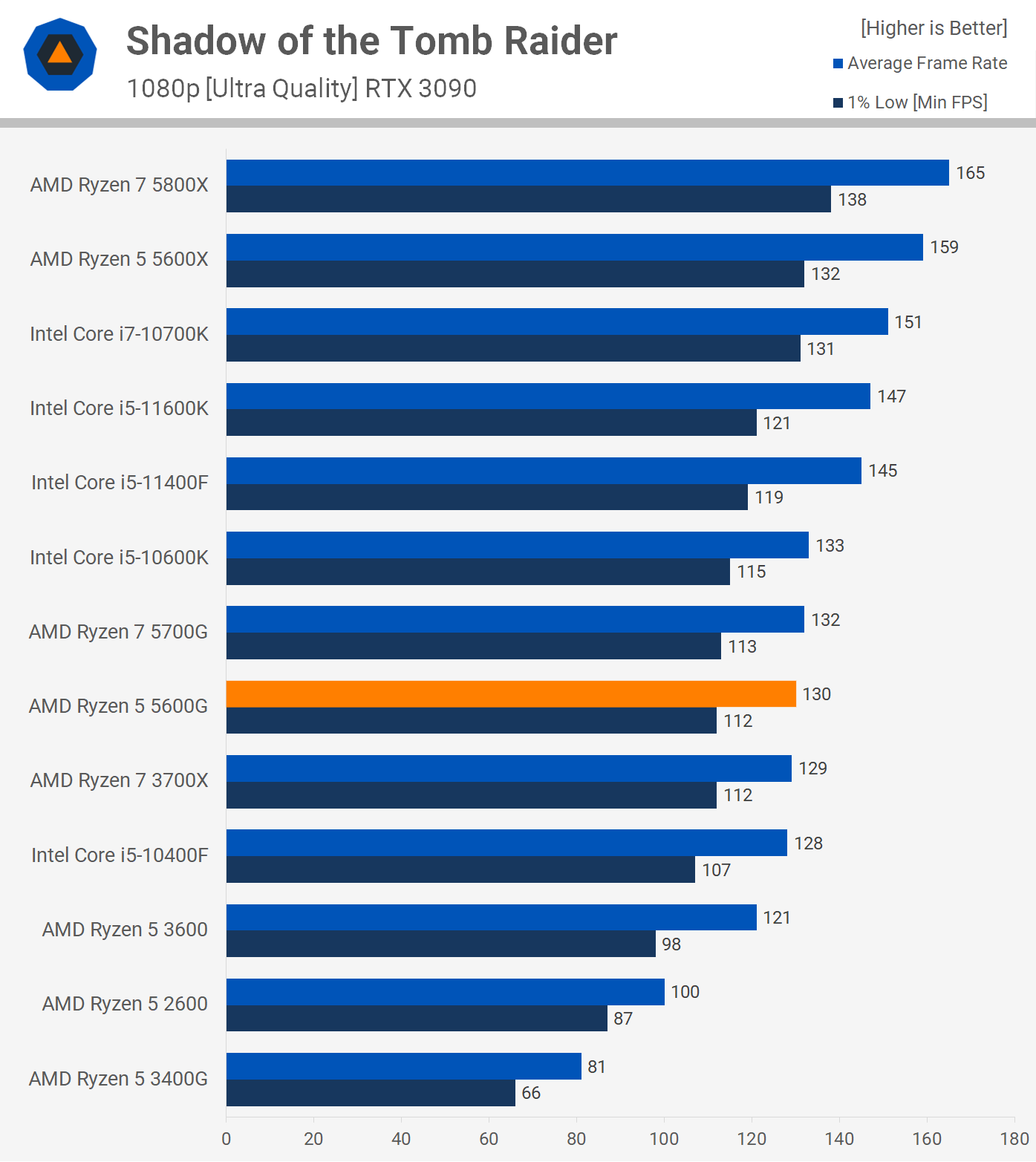
The 5600G was also much slower than the 5600X in Shadow of the Tomb Raider, this time trailing by an 18% margin, rendering 130 fps on average which was comparable to that of the 5700G, 3700X and 10th gen Core i5 processors.
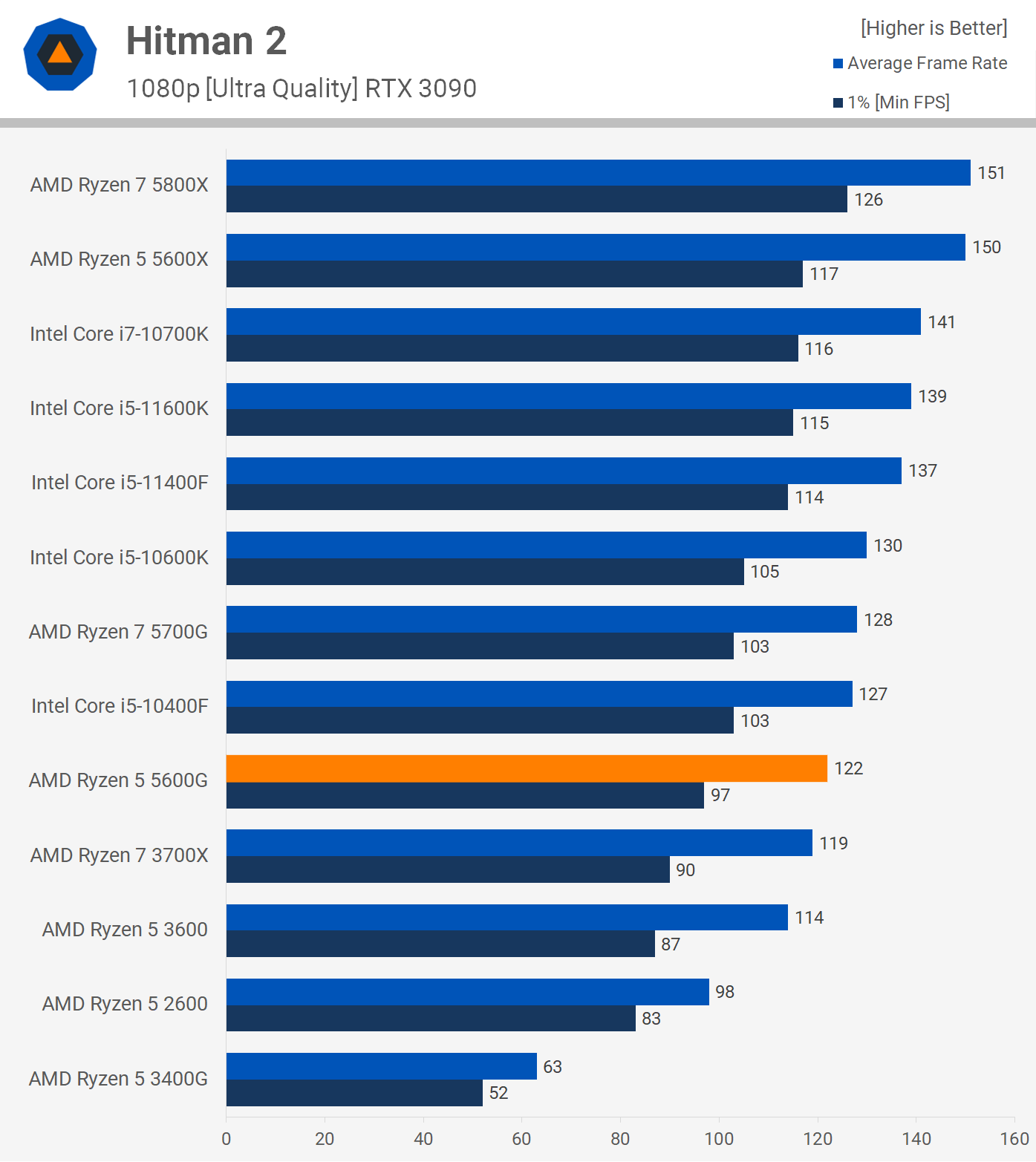
In Hitman 2 the 5600G is much slower than the 5600X once again, trailing by 19% with an average of 122 fps opposed to 150 fps for the 5600X. The 5600G is similar to the 3700X when it comes to high-end gaming performance, and while that's not a terrible result, it's not exactly what we've come to expect from the Zen 3 architecture.
dGPU Gaming Performance Overview
Finally, we have the 10 game average data and as expected given what we just saw, the 5600G is only comparable with the 3700X when it comes to high-end gaming using a powerful discrete graphics card. Of course that's not bad, but it does mean cheaper parts like the 10400F will deliver comparable or often better performance.
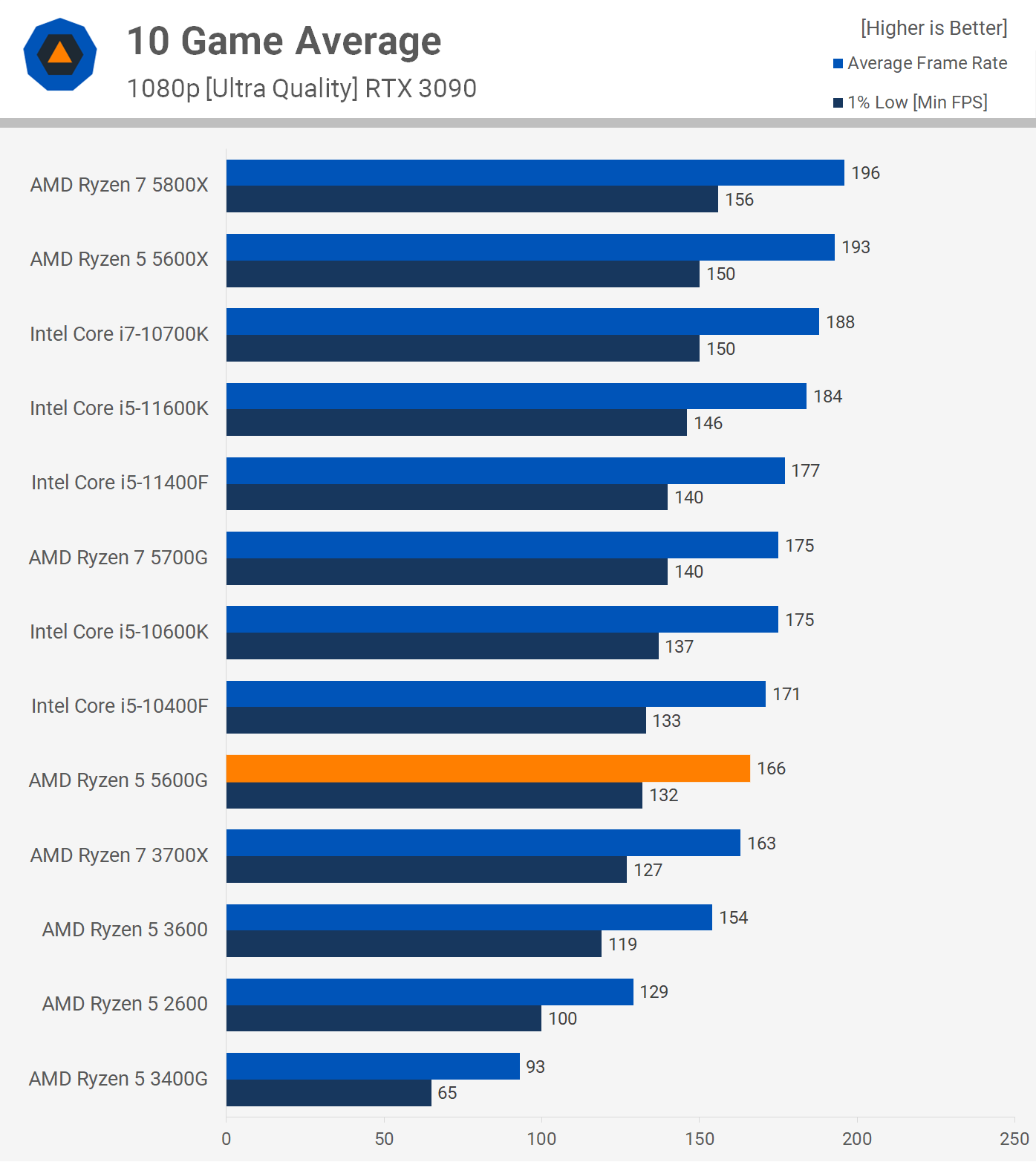
It also means when CPU bound the 5600G was on average 14% slower than the 5600X, which is a reasonably large margin. Of course it's well worth noting that for the majority of gamers, and hardware configurations, the performance difference between these two CPUs is going to be very small as you'll almost always end up GPU limited.
So keep in mind the fact that we are testing with a GeForce RTX 3090 at 1080p, using a lower tier GPU such as the RTX 3070 at 1440p will see the margins shrink to less than half of what's shown here.
What We Learned
It's worth mentioning that AMD is positioning the 5000-G series as flexible, scalable and accessible APUs for PC enthusiasts, said to deliver exceptional price to performance for gaming focused PCs. They even go as far as to say "incredible gaming on Radeon IGP." So make no mistake, AMD is pushing the 5600G and 5700G as gaming-focused products.
How incredible the gaming experience is really depends on the game. In modern and even relatively modern AAA titles, you're typically looking at around 30 fps at 1080p using the lowest quality settings. Now, that might be incredible by iGPU standards, but overall it's pretty miserable when compared to multi-generation old discrete GPUs.

With the right selection of games though, the 5600G can look quite good – games like CS:GO, League of Legends, Dota 2, Fortnite and F1 2020, for example. So as long as you go into this with the right expectations, gaming can be enjoyable with the 5600G standalone.
Priced at $260, it certainly makes a lot more sense than the 5700G, especially for gaming. These days you're looking at ~$200 for a decent used graphics card – like the 3GB GTX 1060 – so it's hard to beat the value of 5600G by doing what we suggested when reviewing the 5700G, which was to buy a Core i5-10400 and a second hand GPU.

Ideally, we'd prefer to see the 5600G priced closer to $200, but even if that's not so, we can make a case for it at $260, and in our opinion that's not possible for the 5700G at $360.
The Ryzen 5 5600G is also far more suitable than the 5700G as a stop-gap for those holding out for GPU pricing to recover, and it's much more economical for use in home theater PCs. So as we see it, there's far more use cases where the 5600G makes sense and that makes it a more valuable product in our opinion.
